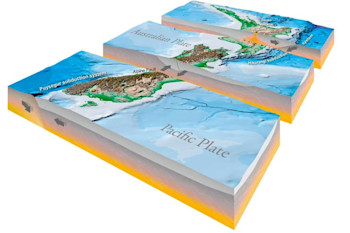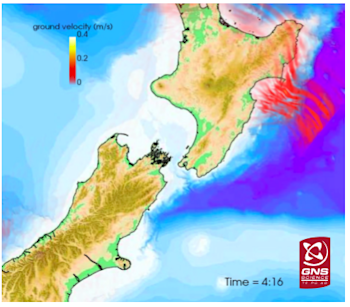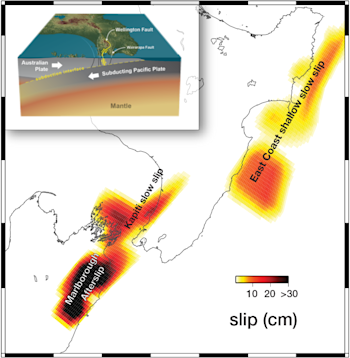
GeoNet data used to produce state-of-the-art slow slip earthquake models
Last November’s magnitude 7.8 Kaikōura earthquake caused a series of major slow slip earthquake events beneath and offshore the North Island - and we have state-of-the-art models to show what was going on.
The M7.8 Kaikōura earthquake was one of the most complex earthquakes ever recorded with modern instruments. Among the earthquake's impacts was the most wide-spread occurrence of slow slip in New Zealand since 2002 and, our scientists tell us, probably the clearest example worldwide of long distance, large-scale slow slip triggering.
What you need to know about slow slip earthquakes
Slow slip events are similar to earthquakes but different at the same time.
Similar because they involve more rapid than normal movement between two pieces of the Earth’s crust along a fault. And different because unlike earthquakes, where the movement occurs in seconds, movement during these slow slip earthquake events can take weeks to months to occur. The release of energy and ground movement is incredibly slow so we don’t feel them at the surface like an earthquake - but GPS instruments that monitor ground movement do.
Slow slip events often occur at the subduction zone interface - where two tectonic plates meet.
Tectonic plates move toward each other and where one dips below the other the area is called a subduction zone. We have two subduction zones in New Zealand. The Puysegur subduction system south of the South Island, where the Australian Plate dips below the Pacific Plate, and the Hikurangi subduction system off the east coast of the North Island, where the opposite is going on and the Pacific Plate dips under the Australian. In the middle the two plates move past each other laterally and we have the Alpine Fault.
Now, there are a few extra details going on where the “dipping” part is happening at the interface where the two plates meet. Some of the area can move freely but occasionally some other part can get can get locked and move in the same direction. This builds up tension and when it’s released the movement can be fast (subduction zone earthquake) or slow (slow slip).
Slow slip events are common at the Hikurangi subduction zone. In fact back in 2002 this area of New Zealand, under the seafloor just east of Gisborne, is where these slow slip earthquakes were first observed.
New Research
The M7.8 Kaikōura earthquake in New Zealand’s South Island triggered large slow slip events along much of the Hikurangi subduction zone (which is ~600 km away from the earthquake epicentre!!).
Our scientist, Dr. Laura Wallace of GNS Science, tells us “the slow slip event following the Kaikōura earthquake is the largest and most widespread episode of slow slip observed in New Zealand …this is probably the clearest example worldwide of long distance, large-scale slow slip triggering”.
The slow slip event was detected by GeoNet’s continuously operating GPS network. It occurred at less than 15km deep below the surface (or seabed) and spanned an area of more than 15,000 sq km offshore the Hawkes Bay and Gisborne regions.
Dr. Yoshihiro Kaneko, also from GNS Science, explained “the slow slip was triggered by stress changes in the Earth’s crust caused by passing seismic waves from the Kaikōura quake.”
So as the seismic energy that was released from the Kaikōura earthquake moved north it essentially added more tension to the Hikurangi subduction zone and triggered a slow slip event. The illustration below shows the seismic waves from the Kaikōura earthquake – in red lines - at the plate boundary east of the North Island.
This study was unique in that it really took advantage of the extensive coverage of GeoNet’s GPS and seismic network to create incredible models of seismic wave movement. The researchers used GeoNet's strong motion data around the whole country and compared them with computer-generated seismograms, which were computed using New Zealand’s supercomputer called NeSI.
By modelling the movement of the seismic waves and the movement of the plates beneath the North and South Islands we are closer to understanding more about the relationship between earthquakes and slow slip events.
Not all the credit can be given to the work of the Kaikōura earthquake alone. The triggering effect for the slow slip event was emphasized by an offshore ‘sedimentary wedge’ (a mass of sedimentary rock) piled up at the edge of a subduction zone. This sedimentary layer can trap seismic energy, which in turn, can cause fault slip at the base of the sedimentary wedge where the slow slip events occur (at that locked part of the two plates).
Dr. Kaneko added “the study also suggests that the northward travelling rupture during the Kaikōura quake directed strong pulses of seismic energy towards the North Island, which also influenced the long-distance triggering of the slow slip events beneath the North Island.”
The east coast slow slip event was also responsible for sparking off a series of small to moderate earthquakes off the east coast in November last year. The largest earthquake in this sequence was a M6.0 offshore Porangahau on 22 November. There was also a slow slip event triggered on the subduction zone at 25-40 km depth beneath the Kapiti coast region, which is still ongoing today.
The research was published in Nature Geoscience and there is more to come - the scientists will work on separate research papers that explain the Kapiti and Marlborough slow slip events. If you haven’t already read the Kaikōura earthquake story, take a look here.
Contact: Dr. Laura Wallace, Geophysicist, GNS Science l.wallace@gns.cri.nz
Dr Yoshihiro Kaneko, Seismologist, GNS Science y.kaneko@gns.cri.nz





